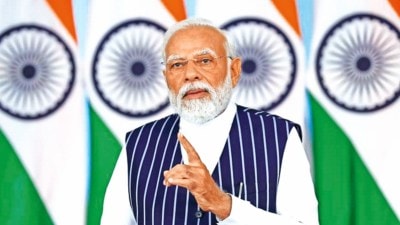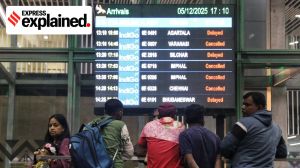Explained: What role do cars really play in fouling New Delhi’s air?
Since 2007, four different studies seeking to apportion the sources of air pollution have reached different conclusions. While vehicular pollution and road dust emerged as major contributors, assessments of the role played by vehicles have varied the most widely.
 The premise behind ‘odd-even’ is that vehicular pollution is a significant contributor to fouling Delhi’s air. (PTI File photo)
The premise behind ‘odd-even’ is that vehicular pollution is a significant contributor to fouling Delhi’s air. (PTI File photo)
Delhi Chief Minister Arvind Kejriwal has announced a return of the odd-even road rationing scheme for the city— between November 4 and November 15, odd-numbered private cars would be allowed on the roads only on odd dates, and even-numbered cars on even dates.
Exemptions, if any, were not immediately known, even though the last time Kejriwal’s government experimented with the scheme, between January 1 and January 15, 2016, women drivers and two-wheelers were exempt.
The premise behind ‘odd-even’ is that vehicular pollution is a significant contributor to fouling Delhi’s air. On Friday, Kejriwal said a 10%-13% reduction in air pollution could be expected as a result of the road rationing scheme. Road Transport and Highways Minister Nitin Gadkari countered that odd-even was not needed because “the new ring road we have built is helping reduce pollution”.
While Kejriwal also announced other steps to combat air pollution such as buying masks, sprinkling water, planting saplings, appointing environment marshals, and holding a free public laser show to dissuade people from bursting crackers on Diwali, there still remains some confusion on exactly what causes Delhi’s infamous pollution.
Four studies, four conclusions
Back in 2003, a white paper published by the union Ministry of Environment and Forests had reported that in the three decades between 1970-71 and 2000-01, the contribution of vehicles to particulate matter in Delhi’s air had more than trebled to 72% from 23%.
Since then, at least four major studies have been carried out by government organisations. These source apportionment studies have differed with each other on the relative contribution of sources of particulate matter in Delhi’s air. Crucially, while vehicular pollution and road dust have emerged as major contributors, assessments of the role played by vehicles have varied the most widely.
READ | Delhi’s odd-even scheme in 2016: Challenges and lessons
Feb 2007, IIT-Delhi
This was “A Detailed Study to Ascertain the Effect of Diesel Operated Trucks, Tempos, Three-Wheelers and Other Commercial Vehicles on the Ambient Air Quality of Delhi”, sponsored by the Department of Environment, Government of the NCT of Delhi. The principal investigator was Prof Pramila Goyal of the Centre for Atmospheric Sciences, IIT-Delhi.
BACKGROUND: The 2010 Commonwealth Games were three years away, and the Delhi government was concerned about the massive increase in the number of vehicles in the city. “Vehicles in Delhi increased phenomenally from 2.3 million in 1975 (MOEF, 1997) to 4.2 million in 2004, [and] has been estimated [to go up to] 7.2 million in 2016 on the basis of transport data obtained from Transport Department, 2004,” the study noted.
The study was commissioned to specifically understand the contribution of vehicles of different types to vehicular air pollution. Officials said at the time that measures to mitigate air pollution generated by vehicles were not yielding results quickly enough.
WHAT THE STUDY FOUND: The study concluded that “control on emissions of pollutants from vehicular traffic necessitates the control on the new registration of commercial diesel vehicles in Delhi”.
It noted that the “emission of air pollutants [is] directly proportional to the number of vehicles and concentration of ambient air pollutants is also directly proportional to the emission of air polluting sources”.
A key finding was that “tempos contribute maximum amount of concentration of NOx and PM (58%) followed by trucks (24.1%), buses (12%), cars/taxis (9.7%), small trucks (3.7%) and tractor, trailer (0.18%).”
It suggested that “control may require[d] on the new registration of diesel tempos and trucks”.
Dec 2008, NEERI, Nagpur
This study was titled “Air Quality Monitoring, Emission Inventory & Source Apportionment Studies for Delhi”, and was carried out by the Central Pollution Control Board (CPCB) with National Environmental Engineering Research Institute (NEERI).
BACKGROUND: The study was commissioned after the need for “better understanding” of air pollution sources was “recognised” in the Auto-Fuel Policy Document, 2002.
“With this in view, oil companies in India, in association with premier research institutions, joined together with the stewardship of CPCB and MOEF to initiate a detailed study for source apportionment of ambient air pollutants,” the study said.
The study was carried out in collaboration with oil marketing companies led by Indian Oil Corporation Ltd (IOCL), and the Automotive Research Association of India (ARAI), Pune, “for development of emission factors for vehicles”.
WHAT THE STUDY FOUND: The study identified road dust as the biggest contributor (52.5%) to particulate matter in Delhi’s air, followed by industries (22.1%). It attributed only 6.6% of particulate emissions to vehicles.
The study found industries contributed 79% of the NOx, and vehicles only 18%; vehicles were, however, the main source of CO and hydrocarbons (59% and 50% respectively).
The study said: “Maximum vehicular pollution and road dust generation is estimated in the nearby area of India Gate.”
2011, SAFAR
This was the “Emissions Inventory of Anthropogenic PM 2.5 and PM 10 in Delhi during Commonwealth Games 2010”, carried out by Saroj Kumar Sahu, Gufran Beig, and Neha S Parkhi for the System of Air quality Forecasting and Research (SAFAR) project. It was published in the journal Atmospheric Environment in 2011.
BACKGROUND: SAFAR was developed for air quality forecasting during the Commonwealth Games, and “high resolution Emission Inventory (EI) of PM10 and PM2.5” was developed for Delhi. The inventory had detailed activity data for the region “using Geographical Information System (GIS) technique”.
SAFAR, which introduced the Air Quality Index (AQI) as a new public information tool to measure pollution, was developed by the Indian institute of Tropical Meteorology (IITM), Pune, with weather information and forecasting by the India Meteorological Department (IMD).
WHAT THE STUDY FOUND: This study reached the “surprising” conclusion that road dust from paved and unpaved roads contributed the largest share to air pollution (55%). This was followed by residential sources (15%), transport and vehicular pollution (13%), industrial sources (12%), and power (5%).
“Emission from the unattended source like windblown dust from paved and unpaved roads is found to be the major contributor in PM10 and PM2.5 emissions in Delhi and inclusion of this sector helped in better forecasting skill,” the study said.
“Particulate pollution”, it said, “is a major problem for Delhi specially during winter and fire event festival”, and that the situation with regard to gaseous pollution (such as NOx and sulphur oxides) was “reasonably better”.
Jan 2016, IIT-Kanpur
This was a “Comprehensive Study on Air Pollution and Green House Gases (GHGs) in Delhi (Final Report: Air Pollution Component)”, carried out by Prof Mukesh Sharma and Prof Onkar Dikshit of the Department of Civil Engineering, IIT-Kanpur. It was submitted to the Department of Environment, Government of the NCT of Delhi, and the Delhi Pollution Control Committee (DPCC).
BACKGROUND: The study carried out sampling during the winter of 2013-14 and the summer of 2014. It had five components: air quality measurements, emission inventory, air quality modelling, control options and an action plan.
This study formed the basis of the Graded Action Response Plan (GRAP) framed by the Environment Pollution (Prevention & Control) Authority (EPCA) for the NCR. The EPCA was set up by the central government in 1998 following a directive of the Supreme Court. The GRAP is acknowledged to be a major contributor to the reduction in air pollution levels over the last four years, as announced by Chief Minister Kejriwal last week.
WHAT THE STUDY FOUND: Unlike the 2008 and 2011 studies, this study, while underlining the role of road dust, also stressed on vehicular emissions — moving vehicles, in fact, contributed to over half of Delhi’s air pollution, it said.
For PM2.5, the source apportionment, according to the study, was: road dust (38%), vehicular pollution (20%), domestic sources (12%), industrial sources (11%), concrete batching (6%), hotels and restaurants (3%), municipal solid waste burning (3%), diesel gensets (2%), industrial area sources (2%), and cremation, aircraft and medical incinerators (1% each).
For NOx emissions, industrial point sources (52%) and vehicles (36%) were the biggest contributors, followed by diesel gensets (6%), the study found.
- 01
- 02
- 03
- 04
- 05






































